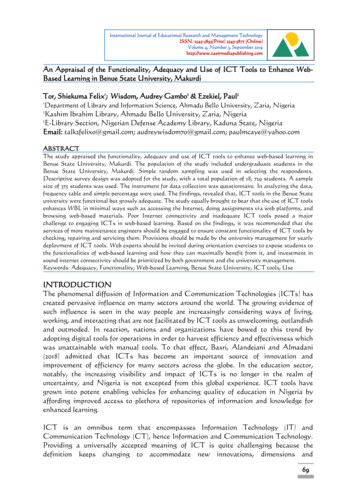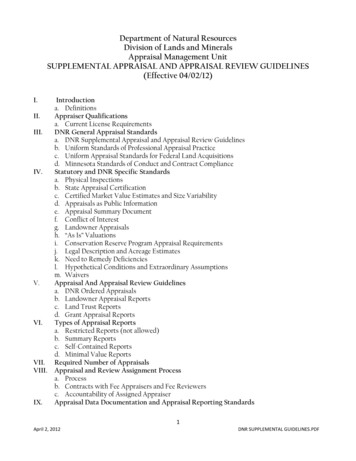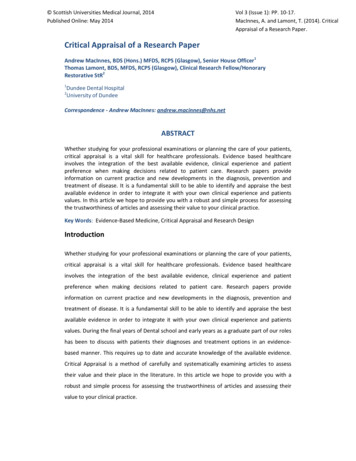
Transcription
International Journal of Educational Research and Management TechnologyISSN: 2545-5893(Print) 2545-5877 (Online)Volume 4, Number 3, September 2019http://www.casirmediapublishing.comAn Appraisal of the Functionality, Adequacy and Use of ICT Tools to Enhance WebBased Learning in Benue State University, MakurdiTor, Shiekuma Felix1; Wisdom, Audrey Gambo2 & Ezekiel, Paul31Department of Library and Information Science, Ahmadu Bello University, Zaria, NigeriaKashim Ibrahim Library, Ahmadu Bello University, Zaria, NigeriaE-Library Section, Nigerian Defense Academy Library, Kaduna State, NigeriaEmail: talk2felixo@gmail.com; audreywisdom70@gmail.com; paulmcaye@yahoo.com23ABSTRACTThe study appraised the functionality, adequacy and use of ICT tools to enhance web-based learning inBenue State University, Makurdi. The population of the study included undergraduate students in theBenue State University, Makurdi. Simple random sampling was used in selecting the respondents.Descriptive survey design was adopted for the study, with a total population of 18, 729 students. A samplesize of 375 students was used. The instrument for data collection was questionnaire. In analyzing the data,frequency table and simple percentage were used. The findings, revealed that, ICT tools in the Benue Stateuniversity were functional but grossly adequate. The study equally brought to bear that the use of ICT toolsenhances WBL in minimal ways such as accessing the Internet, doing assignments via web platforms, andbrowsing web-based materials. Poor Internet connectivity and inadequate ICT tools posed a majorchallenge to engaging ICTs in web-based learning. Based on the findings, it was recommended that theservices of more maintenance engineers should be engaged to ensure constant functionality of ICT tools bychecking, repairing and servicing them. Provisions should be made by the university management for yearlydeployment of ICT tools. Web experts should be invited during orientation exercises to expose students tothe functionalities of web-based learning and how they can maximally benefit from it, and investment insound internet connectivity should be prioritized by both government and the university management.Keywords: Adequacy, Functionality, Web-based Learning, Benue State University, ICT tools, UseINTRODUCTIONThe phenomenal diffusion of Information and Communication Technologies (ICTs) hascreated pervasive influence on many sectors around the world. The growing evidence ofsuch influence is seen in the way people are increasingly considering ways of living,working, and interacting that are not facilitated by ICT tools as unwelcoming, outlandishand outmoded. In reaction, nations and organizations have bowed to this trend byadopting digital tools for operations in order to harvest efficiency and effectiveness whichwas unattainable with manual tools. To that effect, Basri, Alandejani and Almadani(2018) admitted that ICTs has become an important source of innovation andimprovement of efficiency for many sectors across the globe. In the education sector,notably, the increasing visibility and impact of ICTs is no longer in the realm ofuncertainty, and Nigeria is not excepted from this global experience. ICT tools havegrown into potent enabling vehicles for enhancing quality of education in Nigeria byaffording improved access to plethora of repositories of information and knowledge forenhanced learning.ICT is an omnibus term that encompasses Information Technology (IT) andCommunication Technology (CT), hence Information and Communication Technology.Providing a universally accepted meaning of ICT is quite challenging because thedefinition keeps changing to accommodate new innovations, dimensions and69
International Journal of Educational Research and Management TechnologyISSN: 2545-5893(Print) 2545-5877 (Online)Volume 4, Number 3, September s in the ICT world. Nonetheless, ICT consists of diverse but cohesive set ofcomputer-associated technologies used in handling information from its generation toultimate dissemination. In another view, Kaware and Sain (2015) perceived ICT as themanipulation and communication of information by using electronic resources and tools,such as computers, Internet, and broadcasting technologies. It covers digitalinfrastructures that are capable of storing, manipulating, retrieving, transmitting and atthe same time, receiving information (text, sound, motion, etc.) conveyed electronically indigital form. Among such digital infrastructures is the Internet and web technologies,which are key in enabling web-based learning.Web-based learning is one of the monumental educational inventions motivated byexpanding wide range of technologically-empowered channels of interaction andinstruction that afford students an additional and innovative learning atmospherecontrasted with the traditional learning style. In a simplest form, WBL is associated withmultimedia learning materials delivered on World Wide Web and accessed through webbrowser in order to improve knowledge and performance. In other words, Anunobi et al.,(2017) perceived web-based learning as a “hypermedia-based instructional program whichutilizes the attributes and resources of the World Wide Web to create a meaningfullearning environment where learning is fostered and supported”. On one hand, thetwofold definitions succeeded in lime lighting the centrality of Internet and webtechnologies in enhancing access to information resources for flexible, convenient andeffective learning. On the hand, the revelation of the multimedia dimension of WBLbecomes its selling point, since the combination of audio, sound, music, animation, text,video, and images in content delivery makes learning experience more real, motivating andengaging.In view of the above, it is no longer an issue of debate that the influx of Internet and webtechnologies have tremendously revolutionized the landscape of learning such thatsignificant transition is noticed from analogue method that is anchored on chalk and talk,pen and paper, classroom and class teacher, towards new approach of learning that is nolonger confined in the four walls of a traditional classroom, as knowledge can be acquiredon the borderless Internet at anytime, anywhere and by anybody without the limitation ofgeographical space. This underscores the fact that ICT tools have massively revitalizedand reinforced learning by bulldozing the walls of lecture halls known chiefly for verbalexpression method and creating alternative channel of learning via the web. In a quickresponse, Oulmaati, Ezzahri and Samadi (2017) maintained that students’ interest istherefore stimulated to adopt a newer mode of acquiring knowledge for the sake ofimproving their cognitive capacities and developing autonomous learning.Nam and Smith-Jackson (2007) asserted that WBL provides students with a new andwide range of learning experience such as accessing information at any time and place,online presentation of information, interactive task-based activities and effectivedissemination of information. In the same line, Zahiah (2009) submitted that WBLmethod allows individuals to follow learning sessions openly and freely without adhering70
International Journal of Educational Research and Management TechnologyISSN: 2545-5893(Print) 2545-5877 (Online)Volume 4, Number 3, September 2019http://www.casirmediapublishing.comtimetables or attending classes and at their own paces. His disclosure further accentuatesthe flexibility and accommodating capabilities of WBL which made it good newsespecially in attending to students’ diverse learning styles that face-to-face classroominstruction cannot address. Also, Anunobi et al., (2016) added that owing to thenetworking feature of the WBL, it can facilitate enrollment into online courses, providesyllabus of instruction, posting and submitting assignments, interacting with instructorsand co-students, collaborating on assignments, and building learning communities.Considering the ubiquitous impact of WBL, it is progressively gaining popularity inlearning communities among developing nations, and students in Nigerian universitiesare already joining the global race in availing themselves of the tremendous opportunitiesthat accompanied it. On this account, universities are confronted with an increasingpressure and need to adopt digital tools that can accelerate maximal and beneficialparticipation of students in WBL. In corroboration to that, Siddiquah (2017) posits thatadvanced ICT assisted instruction such as web-based learning require properinfrastructures including substantial computers and Internet resources. This follows thatsupporting web-based learning involves provision of functional modern technologicalfacilities in appreciable quantity, and ensuring sustained use of these tools to ensureeffective learning by students via web platforms. It is more so because universities aremissioned to make optimum contribution to national development through high levelmanpower training, and to promote scholarship (NPE, 2004). To achieve this loftymandate entails implementation of educational innovations such as WBL which iscapable of reforming the face of learning in universities in Nigeria.STATEMENT OF THE PROBLEMWeb-based learning is ever more becoming a global trend among universities. This couldbe attributed to the transformation it has brought in decentralizing learning, by ending themonopoly of lecture halls as primary learning platform and creating alternative channelsof instruction through the World Wide Web (WWW). Students are now adopting theirsuitable learning styles to learn at their own convenience, pace and comfort without beingpressured, pressed and punished. This innovation is made possible with the influence ofInternet and other ICT-related tools, which represent modern time vehicles that are beingused to harness WBL. It then follows that in order to benefit from the full potentials ofWBL, absorption of requisite ICT tools into Nigerian university campuses cannot becompromised, seeing that WBL does not thrive in isolation of those digitalinfrastructures. In line with this, growing body of researches (Shidi, 2011; Tor, 2014; Shidi,et al., 2015) reported the presence of ICT tools in Benue State University. However, thereis no particular research embarked upon to uncover how the available ICT tools arecapable of enabling students to exploit web-based learning to augment classroominstructions, hence the need to appraise the functionality, adequacy and use of ICT toolsto enhance web-based learning in Benue State University, Makurdi.RESEARCH QUESTIONS1. What types of ICT tools available in Benue State University are functional?71
International Journal of Educational Research and Management TechnologyISSN: 2545-5893(Print) 2545-5877 (Online)Volume 4, Number 3, September 2019http://www.casirmediapublishing.com2. Which types of ICT tools available in Benue State University are adequate?3. What ways do the use of ICT tools in Benue State University enhance web-basedlearning?4. What challenges do students encounter in using ICT tools in Benue State Universityto enhance web-based learning?LITERATURE REVIEWICT toolsIrrespective of the streams of definitions, Qutab, Bhatt and Ullah (2014) defined ICTtools as “hardware and software usability for information transportation and conductingcommunications linked by a vast array of technological protocols”. From Qutab’s opinion,ICT is not a standalone technology; it involves combination of wide range of technologiesthat harmoniously function for the purpose of information transfer and communication.On the other hand, Kpolovie and Awusaku (2016) looked at ICT as computer-centeredtools adopted by individuals to meet the information processing needs of an organization.More expansively, Fagbe, Amanze and Oladipo (2015) described ICT is a broad-basedterm comprising the gathering (acquisition), organization (packaging), storage andretrieval (dissemination) of information that can be in textual or numerical (books,documents), vocal and pictorial forms (audio–visual) or a combination of all the above(multimedia), using a combination of computer and telecommunications devices. Theauthors extended the understanding of ICT tools from just technological mark-up tovarious formats into which information is translated for delivery to end users. Thisindicates that access and productive participation in WBL can only be enabled by ICTtools. Yusuf, Afolabi and Loto (2013) maintained that ICT tools are an indispensablepart of the contemporary world. The emergence of ICT revolution has dramaticallychanged the way people think, work and communicate in the 21st century. Waghmare andSalved (2014) responded that ICT tools have transformed the higher education scenario. Ithas tremendously broadened the opportunities for people to acquire information, interact,network, address issues of common concern, generate income and participate in society(Oladipo & Akinwunmi, 2015). As a result, these tools have exploded in popularity anduse in recent times. They are now tagged important tools for study, teaching and researchin any academic institutions. Universities are therefore deploying ICT tools to facilitateaccess to information because students largely depend on them for effective learning. SuchICT tools include: desktops, laptops, scanners, digital cameras, projector, Wireless, LocalArea Network, modem, iPod, iPad, tablets, scanner, web boards and so on.Functionality of ICT ToolsBasically, ICT tools are said to be functional when they are in a working condition suchthat they can be accessed and operated by users to achieve practical purposes in goodtime. In a real sense, ICT tools are not to be considered available except they are in afunctioning condition, implying that tools that are physically present but are wanting inserving the intended purpose for procurement cannot be considered functional. Thissuggests that non-functionality of ICT tools goes beyond malfunctions in the facility, tofailure to perform its designated and required functions upon demand. Premised on this72
International Journal of Educational Research and Management TechnologyISSN: 2545-5893(Print) 2545-5877 (Online)Volume 4, Number 3, September ng, functionality of ICT tools in this context is not limited to provision only,it also involves operability and disposability of the tools to students. It is on this strengththat Bekteshi (2015) maintained that the functionality of ICT tools is considerablycontributing in the application of innovations in universities of which is web-basedlearning. In this light, McLoughlin and Lee (2008) credited student-centered learning tofunctional ICT tools. This is evidenced in the accelerated interest among students to useICT tools to learn independently via web platforms. In Nigeria, Mimgba (2011)discovered that most ICT tools were functional in the four studied Federal Universitiesin the Eastern part of Nigeria, since out of the 57 ICT items listed, only 4 items were notfunctional. Similarly, Uduak, Ukpanah and Ebong (2016) discovered computers, printers,overhead projectors, uninterrupted power supply (UPS), digital cameras, scanners, server,and Internet access as the most functional ICT facilities in the university of Uyo,Nigeria. However, Usoro et al., (2012) lamented that key facilities that can support WBLin universities are not always functional. To confirm this, Nuraddeen (2015) reportedlimited number of functional computers and computer laboratories in the university thatformed his study. By implication, the functionality of ICT tools holds high promise forthe thriving of web-based learning while non-functionality of these tools does a lot ofharm to students learning process, especially in this modern era.Adequacy of ICT ToolsIn a simplest form, adequacy involves sufficient quantity and quality of resources foractualizing a particular purpose. Longman (2000) perceived adequacy as a situation inwhich there is enough resources for a particular purpose. Based on the two definitions,adequacy of ICT tools is not only measured in terms of the number of facilities availablebut also in terms of their satisfactory working condition. According to Ojoawo (1990)adequate facilities and equipments form a strategic factor in the functioning of everyorganization, universities inclusive. He furthered that adequacy of facilities influenceefficiency and high productivity in teaching and learning. This suggests that productiveand smooth learning via the web requires adequate ICT tools. It is becoming morenecessary now that students’ population in universities is increasing year after year, andthe intense need of students to exploit more innovative learning atmosphere keepsskyrocketing. Mapaderum (2002) attributed effective learning by students to adequacy offacilities, including ICT. In their study, Atsumbe et al., (2012) discovered inadequate elearning infrastructures in the studied university. Similarly, Akindoju et al., (2014)reported inadequacy of ICT in tertiary institutions. Nuraddeen (2015) found out that ICTresources are wanting in universities and very inadequate for students to use. As a result,Maduewesi (2010) traced poor academic performance to inadequate facilities in learningenvironments. With this, web-based learning which is supposed to be the birthright ofevery student may be exploited by few privileged students, thereby denying a chunk ofothers the opportunity of building themselves up. The end result is poor academicperformance, leading to production of half-cooked graduates that cannot compete withtheir contemporaries outside the shores of Nigeria.73
International Journal of Educational Research and Management TechnologyISSN: 2545-5893(Print) 2545-5877 (Online)Volume 4, Number 3, September 2019http://www.casirmediapublishing.comUse of ICT ToolsUse of ICT tools involves operating or manipulating computer-associated devices toaccess, utilize and share information. Selwyn (2008) observed that ICT use is almostcertainly an integral element of thriving in the modern society. It is so because ICT use ispoised to enhance well-being, principally when employed to actualize important ormeaningful goals (Sims et al., 2017). It therefore means that learning goals cannot besatisfactorily actualized in the 21st century except with the use of ICT tools. In agreementto this, students attested that the use of ICT supports their learning (Siddiquah & Salim,2017). In the same line of discoveries, Onyia (2013), Osuchukwu, Obuezie and Ogwuche(2017) found out that university students use ICT facilities to improve their studies.Oulmaati, Ezzahri and Samadi (2017) revealed that nearly two-thirds of the studentsstudied use ICT tools to always search for information on Web sites. Hamzah, Ariffinand Hamid (2017) attributed that to online discussion forums in web-based learning thatcan be used to discuss assigned tasks. However, Umunadi (2011) and Nuraddeen (2015)decried improper or non-use of ICT tools by students in universities. Stressing thebenefits of using ICT tools, Caluza et al., (2017) noted that one of the forces generatingattention to use of ICT tools is the increasing need to achieve lifelong learning.Innovations driven by ICT such as web-based learning helps in facilitating lifelonglearning, by making learning occur anytime and anywhere outside the vicinity of aphysical classroom. Mereku et al., (2009) quickly observed that students are equipped withskills to search for information, resulting to them gaining more knowledge of some of thetopical issues they study in many subjects. As a result, they confidently give inputsduring class discussions and have better understanding of abstract ideas and concepts.This proposes that productive use of ICT helps students in building their cognitivecapacities, and encourage independent learning. ICT tool use helps students to discoverlearning topics, solve problems, and provide solutions to problems in the learning process(Brush, Glazewski & Hew, 2008). In another view, Mbengo (2014) added that ICT usebrings greater access to knowledge, and improve archival capability of knowledge.Web-based Learning and Nigerian UniversitiesWhile some use web-based learning in the context of online self-study, others perceive itas pieces of content packaged with the aid of technical tools. Relan and Gillani (1997)perceived WBL as a cognitive learning strategy application in a constructive andcollaborative learning environment using web facilities. Khan (1999) understood WBL aslearning program based on hypermedia that uses characteristics and sources from the webto generate a meaningful and supportive learning environment. Za ıane (2001) definedWBL as learning environment in which Internet technology become the primary becomesmedium for delivering the teaching and learning courses quickly. Tsai and Machado (2019)associated WBL with learning materials delivered in a Web browser, including when thematerials are packaged on CD-ROM or other media. The directly above definitionshighlighted the reality that the development of Internet and the World Wide Web(WWW) in learning environment have initiated active learning among students andenable them to acquire learning materials toward improving knowledge and performance.74
International Journal of Educational Research and Management TechnologyISSN: 2545-5893(Print) 2545-5877 (Online)Volume 4, Number 3, September 2019http://www.casirmediapublishing.comWeb-based learning is often used in literatures interchangeably with e-learning and onlinelearning. Even as they are widely confused as interchangeable terms, there still exist asubtle but substantial difference between WBL and the rest. Ezenwafor and Soneye(2018) noted WBL as a subset of e-learning. Za ıane (2001) considered WBL as one of thedistance learning strategies. Tsai and Machado (2019) explained that e-learning involvesactivities that do not require learning materials to be delivered by computer, but computerand networks must be involved in this type of learning. While online learning is associatedwith readily available learning materials in a computer environment, which network use isnot necessarily required to access them. Therefore, the core distinguishing feature of WBLfrom other types of learning, is web-based learning contents are delivered in web formatand are typically retrieve from a website. It has to do primarily with contents in a webbrowser and not just activities that involve computer and networks without learningmaterials being delivered by computers. Tsai and Machado (2019) pointed that thediscriminating feature of each of them must be the primary characteristic of the learningactivity. The authors added that intensive use of the feature is required, since incidental oroccasional use of a characteristic feature is not enough to qualify for a certain type oflearning.According to Khan (1997) WBL possess main and additional characteristics. The mainattributes include interactivity, allowing online search without distance and timelimitation, comprising multimedia elements, and can be accessed globally by students.The additional attributes include online assessment, cost-saving, ease of use and others.Still on features, Baharuddin (2001) echoed that learning through the website shouldproduce genuine learning context, involve solving real problems, include initiative to learnindependently in a skill, consist active discussion between students and teachers, ensurecollaborative and cooperative learning, and enable learning assessment strategies toevaluate the actual skill. Lynch and Lynch (2017) observed that WBL has seven importantfunctionaries: discussion board and chat rooms, real time announcements, automatedquizzes, posting of text, html, spreadsheets, videos, PowerPoint, audio files, real timegrade book, external links, and emails to individuals. All these functionalities make WBLa hotcake amidst students in this Internet age. Quadric (2014) observed that WBLinvolves learning at all levels, both formal and non-formal, that uses information networkwhether wholly or partially, for course delivery, interaction and/or facilitation. Generally,Olaniyan (n.d) observed that many universities in Nigeria are yet to enjoy the benefits ofweb-based educational system. Adeola, Adewale and Alese (2013) revealed that theNigeria Open University is the closest to web-based learning in that the institutioncombines traditional learning method with web-based instruction materials. Edewor,Imhonopi and Urim (2014) reported the presence of e-conferencing service in covenantUniversity. Adeyinka, Bashorun and Adu (2012) discovered that the adoption of webportals in the University of Ilorin has enabled students to learn through the electronicformat and share information. Adibi and Foluke (2019) bared that a larger number ofstudents in university of Ibadan are already familiar with web 2.0 learning tools and areusing them for educational purposes. However, Omo-EHu (2001) in Okereke (2005)echoed that in developed countries, web functionalities have been used in the teaching and75
International Journal of Educational Research and Management TechnologyISSN: 2545-5893(Print) 2545-5877 (Online)Volume 4, Number 3, September 2019http://www.casirmediapublishing.comlearning process for several years. In support, Ubulom and Ogwunte (2017) reminded thatmost tertiary institutions in developed countries have gone far with WBL in form ofonline lectures and other educational activities.Challenges of using ICT tools to enhance web-based learningAccording to Brown (2002) the major problems challenging the use of ICT tools inenhancing WBL is ease of finding and understanding technology, and individual usercharacteristics such as self-efficacy and computer anxiety. In their study, Anene, Imamand Odumuh (2014) found ICT deficiencies as a major challenge in exploiting ICTs.Chiaha, Eze and Ezeudu (2013) unearthed in their study that irregular electric powersupply and poor network connection resulted to majority of the students only accessingemail accounts and missing out in several other tasks. Fagbe, Amanze and Oladipo (2015)reported poor attitude toward change in technology as a challenge. Poor attitude totechnology actually slows down every quest for acquiring new skills and applying them toweb learning. Poor maintenance culture has also constituted a great challenge in usingICT by students in universities (Fagbe, Amanze & Oladipo, 2015; Ezeugwu et al. 2016).Improper maintenance of ICT facilities hinders their durability and render non-functionalfacilities that would have been used to support web-based learning. Absence of enablingenvironment, including highly regulated telecommunication industry, unsatisfactoryperformance of Internet service providers keeps students from using ICT tools to learn(Drummond, Sheperis and Jones, 2016). Generally, Ubulom and Ogwunte (2017)submitted that the integration of web based instructional facilities in Nigerianinstitutions has witnessed slow growth.RESEARCH METHODOLOGYResearch DesignDescriptive survey design was adopted for the study. Survey research design is bestapplicable to phenomena that is investigated through garnering information from theopinions, believes and attitudes of the respondents. The design is relevant to this studybecause it involved sampling the opinions of students on the functionality, adequacy anduse of ICT tools to enhance web-based learning in Benue State University, Makurdi.Population of the StudyThe population of this study constituted all the regular undergraduate students in BenueState University, Makurdi, which amounted to 18, 729 students (BSU Brief History,2019). Simple random sampling technique was employed to select the sample. The samplesize for a population that falls within the range of 1800-1899 according to Krejcie andMorgan (1970) table of determining sample size is 317. Therefore, the sample size for thetotal population of 18, 729 students is 375 undergraduate students.Research InstrumentQuestionnaire was selected as the instrument for data collection. The questionnairecontained four sections (A-D). Section A consisted of nineteen (19) items on thefunctionality of ICT tools in Benue State University. Section B consisted of nineteen (19)76
International Journal of Educational Research and Management TechnologyISSN: 2545-5893(Print) 2545-5877 (Online)Volume 4, Number 3, September 2019http://www.casirmediapublishing.comitems on the adequacy of ICT tools in Benue State University. Section C contained nine(9) statements on the ways ICT tools enhance web-based learning. While Section Dconsisted of seven (7) items on the challenges of using ICT tools in enhancing web-basedlearning.Validity and Reliability of the InstrumentIn order to ensure that the instrument supplied the required data for this study, theinstrument was exposed to content validation. An expert scrutinized and modified eachquestion to ensure that it is an accurate measure of the desired content. While forreliability of the instrument, the instrument was tried on ten (10) students in AhmaduBello University, Zaria, and the Cronbach alpha reliability test was used to test theinternal consistency of the instrument, using Statistical Package for the Social Sciences(SPSS). A reliability level of 0.799 was obtained which guaranteed the reliability of theinstrument.Procedure for Data AnalysisThe data collected from the field via questionnaires was analyzed using descriptiveanalysis in form of frequency distribution and simple percentage. The bench mark of 50%was used for decision. Any item that ranked from 50% and above was regarded asfunctional/adequate/accepted; while any one from 49% and below was regarded as notfunctional/not adequate/rejected.PRESENTATION OF RESULTSTable 1: Functionality
1Department of Library and Information Science, Ahmadu Bello University, Zaria, Nigeria 2Kashim Ibrahim Library, Ahmadu Bello University, Zaria, Nigeria 3E-Library Section, Nigerian Defense Academy Library, Kaduna State, Nigeria Email: talk2felixo@gmail.com; audreywisdom70@gmail.com; paulmcaye@yahoo.com











